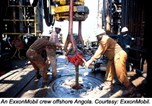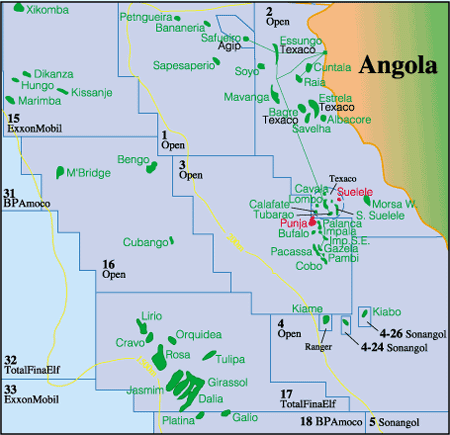Angola calling for slow down in oil projects

By Moses Aremu, Lagos
Angola is slamming on the brakes. The fastest growing sector in the West African oil patch is slowing down the pace of execution of oil projects. This is not the picture that immediately comes across when you count the number of drilling rigs in the Angolan deepwater. As we write, ExxonMobil, having plugged and abandoned Vicango-1 untested, is currently testing Mavacola-1 in Block 15. BP has just plugged and abandoned Cobalto-1 in Block 18. Agip is drilling Leao-1 in Block 25. With five locations active simultaneously at anytime, the Angolan deepwater is still the busiest scene along the West African deepwater fairway. And more is coming.
BHP will spud the first of five commitment wells in Block 21 this summer on a prospect located in 1,600 meters water depth.
Some companies can't wait. TotalFinaElf terminated a three-year contract on the SedcoExpress owing to the rig's delayed delivery beyond December 28, 2000.
BP wants to be the first operator to drill in one of the three ultra-deepwater leases awarded last year. It plans to spud in Block 31 by May 2001.
So what is this talk about slowing down?
The reason proffered by the government: "to preserve the huge reserves for future generations," has been as astounding to operators as the decision itself. Carlos Satorniro, planning and business manager for state-owned oil company Sonangol, told the press, "If we produce oil in a reasonable way, we can use the funds to rebuild the country."

Angola has been at war since before and after independence from Portugal in 1975. Its most prized natural resources have paid for the effort both ways; the government, controlling much of the coast and offshore whence the oil is extracted, has used the oil wealth for its campaigns. The rebel forces, controlling much of the vast diamond mines, have used the diamond wealth to fight the government forces. But in late 1999, the government made decisive raids on rebel strongholds and severely weakened the enemy. In the last year, amnesty was offered to any rebel who gave himself up.
Unclear is whether it is this apparent military victory, carrying with it the reduction in pressure to generate oil wealth, that gives the government the reason to call for a slowdown in oil projects. Or is it the World Bank's recent criticism of the lack of transparency in deploying oil receipts. The government has not entirely dismissed the suggestion that the slow-down is in sympathy with OPEC's output restraint, saying only that it has commissioned a study to determine how to manage Angola's oil reserves in the long term.
The Angolan crude oil reserve base has had rapid growth since the country joined the deepwater foray in 1995. Estimated recoverable reserves stand at six billion bbl, suggesting an average discovery of over one billion bbl a year. This puts the regional oil giant Nigeria (with an estimated 3.5 billion bbl in deep water) at a distant second. But Nigeria still holds the ace, with a total of 22 billion bbl in place (on land, swamp, shallow offshore, as well as in deep water).
The high rate of new discoveries and the rapid build up in reserves has lured operators far and wide to the Angolan deepwater, causing companies to pay a total of US$900 million in signature bonuses for three leases in the aftermath of one of the most hotly contested bidding round in the world in 1999. Analysts say that the value of an Angolan deepwater lease will fall in the wake of the implementation of the slowdown philosophy.
In calling for a slowdown in pace of oil projects, the Angolan government has not openly mentioned any project. But analysts are rounding up some well known suspects: TotalFinaElf's 800 million bbl Dalia Field in the prolific Block 17 and ExxonMobil's highly publicized Kizomba cluster development in Block 15—both scheduled to come on stream in 2004.
Work has reached an advanced stage in TFE's flagship deepwater project Girassol (Block 17), that it will not be affected by this slowdown strategy. The field is expected to come on stream in the fourth quarter of 2001.
The Dalia Field may have a jump start on the Kizomba development. After waiting two months for approvals from Sonangol, TFE was able to issue invitations to tender for the subsea hardware on the Dalia project in mid-January. The $400 million contract features 68 subsea trees, project management consultancy, jumpers, manifolds, intervention tooling, and umbilicals. The contract for the flowline and riser is different. Proposals for all these jobs are expected to be submitted by April.

ExxonMobil had had more problems with Sonangol, which seems to prefer it develop one field at a time, instead of developing Dikanza, Marimba, Kissanje, and Hungo in a cluster called Kizomba. In fact, the first statement the government made about the slowdown strategy came in connection with the instruction to ExxonMobil to cancel a $3.1 billion tender involving an FPSO and a production spar for the Kizomba project. Sonangol said that ExxonMobil had gone ahead with the tender without consulting the government.
However the slowdown strategy will play out, it seems Angola is no longer excited by the prospect of doubling its production from 750,000 b/d in 1999 to 1.5 million b/d in 2005. The forecast for 2000 was 780,000 b/d, but actual production hovered around 755,000 b/d. The best forecasts for the first three quarters of 2001 are around 735,000 b/d, but production is expected to jump once Girassol comes on stream, to 935,000 b/d by March 2002.
What's most certain is that Sonangol is going to increase its already strong presence in the Angolan oil industry. ABB is currently doing the basic engineering on the Dalia FPSO which will be slightly larger than the Girasol's two-million bbl storage vessel. The Dalia project has gotten this far due to an understanding with Sonangol, which ExxonMobil has not been able to manage.
The example of Kizomba will suggest that Sonangol will want to get involved in the FPSO in Dalia.
Sonangol is involved in Chevron's Kuito Field, the only deepwater field on stream off Angola, through a joint venture, Sonasing JV, with Single Bouy Mooring. Analysts insinuate that Chevron's FPSO deal with Sonangol enabled the company to bring Kuito into production so fast, ahead of other deepwater field developments. Such argument loses merit because Kuito is located in less than 400 meters of water just offshore Block 0, where Chervon already has producing facilities, but the rest, Girassol, Dalia, and Kizomba, are in excess of 900 meters of water, and thus require more complicated production engineering.
